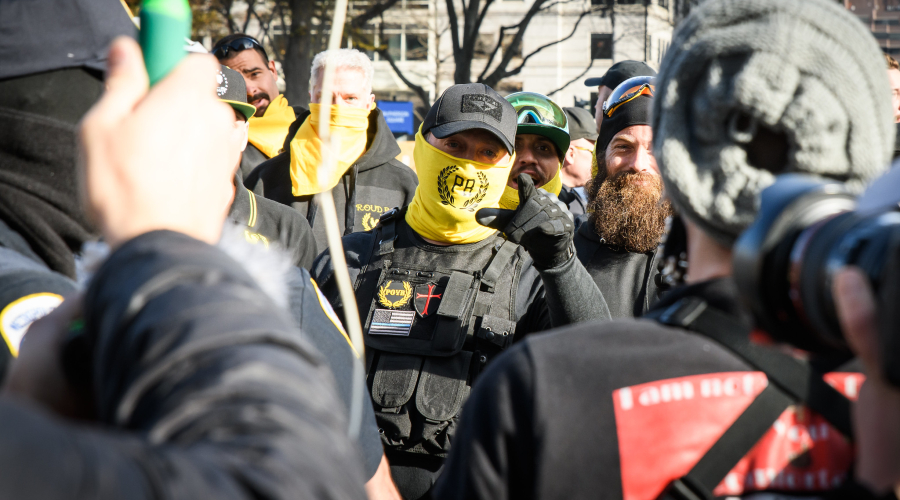Blurry Ideologies and Strange Coalitions: The Evolving Landscape of Domestic Extremism
Four factors are driving the increasing hybridization of extremist ideologies.

Published by The Lawfare Institute
in Cooperation With

Editor’s Note: For years, counterterrorism officials and outside analysts alike have relied on identifying distinct groups or at least analytic categories to sort terrorist and other violent threats. However, weird hybrids regularly emerge, with previously distinct right- and left-wing extremists converging in dangerous ways. Cynthia Miller-Idriss and Brian Hughes of American University examine these strange coalitions, describing their emergence and identifying the factors that drive them.
Daniel Byman
***
Over the past several months, far-right extremists have valorized the Unabomber and praised the Taliban. A re-launched white supremacist group announced a new “Bolshevik focus” calling for the liquidation of the capitalist class. A burgeoning ecofascist youth subculture—spread largely through social media imageboard accounts and commercial merchandise—celebrates nature worship and rootedness within a physical homeland while calling for a white ethnostate.
Coming on the heels of a violent insurrection at the U.S. Capitol at the hands of a strange coalition of unlawful militias, white supremacists, QAnon conspiracy theorists, Proud Boys and ordinary Trump voters, these trends highlight the strange and unanticipated ways in which domestic violent extremism scenes in the United States are fragmenting and reassembling. The transformation is taking place both organizationally and post-organizationally.
On the organizational side, political violence is emerging from a loose new coalition that spans the extremist spectrum in ways that muddle the ideological basis typically understood to be at the root of terrorist and extremist violence. On the post-organizational side, exposure to extremist content and radicalization into ideologies and violence outside the boundaries of organized groups is increasing—largely through online encounters with propaganda, disinformation and extremist ideas.
The new coalitions became especially visible as the coronavirus pandemic began, when protests against shutdown orders and mask mandates drew thousands to state capitol buildings. These protests brought together groups whose interests are not typically aligned—heavily-armed unlawful militia members, conspiracy theorists waving QAnon signs, and anti-vaxxers whose traditional base draws primarily from leftist and alternative medicine spaces. They were mobilized by their single common denominator: anti-government sentiment about management of the pandemic.
This breakdown in previous ideological boundaries has continued. Boundaries have melded between those who believe in radical ecology and the preservation of natural ecosystems and those who believe that environmental sustainability is linked to racial entitlement to the land and requires extreme immigration control or deportation. Some “boogaloo” adherents who advocate a new civil war marched alongside racial injustice protesters because of shared anger at law enforcement. Small but highly vocal contingents such as the “post-left” and “national Bolshevik” tendencies have come together to form a cross-ideological anti-capitalist column, which expresses itself in social media churn through disparate fragments of culture war talking points, Stalinism and fascism all tossed together.
In many ways, the phenomenon is nothing new. Extremist scenes and movements have experienced internal fissures, infighting and fragmentation for years due to differences in beliefs about tactics (such as the use of violence), conflicting views on particular parts of their ideology (such as about Jews and whiteness) or restrictions on who can be members (such as women). Increasingly, this conflict is occurring not just across relatively bounded groups but also among a broad muddling of ideological beliefs within domestic and international extremist scenes, movements and individuals. These trends are different from previous iterations of extremist fracture and reformation.
There are at least four reasons for the increased muddling of ideological rationales: the increasing ability of cross-ideological concepts to mobilize violence, rising event-driven violence, tactical convergence and communication infrastructure.
The merging of extremist ideologies is encouraged by the employment of ideas embedded with a simultaneous call to action, what we call “mobilizing concepts.” They are different from traditional ideological frameworks, which are rooted in more clearly articulated beliefs or theories about how political or economic systems should work, such as anarchism, communism or fascism. Mobilizing concepts, on the contrary, can be applied to a wide range of ideological frames or justifications. They include the notion of the “boogaloo” (a code word for a second civil war), the concept of the “three percenters” (based on the false claim that it took only three percent of colonists to rise up against the British), and the idea of a threat to “Western values.” All three justifications have the potential to mobilize significant cross-ideological support around a concept, rather than an ideology.
Event-driven political violence and extremism refers to relatively spontaneous coalitions across ideological groups and movements that emerge around a common protest or demonstration. The state capitol protests related to coronavirus mandates is one example; the Jan. 6 insurrection at the U.S. Capitol is another. Event-driven ideological coalitions emerge based on opportunities to assemble larger groups of people by focusing on the lowest common denominator that unites them, thereby creating a temporary convergence across myriad ideologies and extremist cultures.
It’s not only concepts and events that lead to cross-ideological muddiness and coalition-building. There has also been increasing strategic and tactical convergence in ideologically agnostic ways, especially around the idea of accelerationism. Accelerationism is a goal and a tactic drawn on by a variety of movements that are united around the objective of overthrowing the country’s prevailing political and social order. Extreme environmentalists might use the tactic to accelerate violence directed against commercial logging companies, for example, while anti-government extremists would use it to target elected officials or government buildings. Accelerationist objectives converge around the idea of inspiration; their promoters see their goals not as mere terrorist retaliation or intimidation but, rather, as focused on inspiring others to undertake similar violence and accelerate the collapse of systems that extremists believe must be demolished and reconstructed. As a strategic orientation, the tactic has been growing across the political spectrum.
Fourth and finally, material infrastructure enables the muddling of ideological rationales. Specifically, digital media shapes the communication and consumption of ideological content. The infrastructure of digital communication technology, at both engineering and design levels, makes motley ideological blends increasingly common—and perhaps even inevitable. The arrival of the hyperlink has made it orders of magnitude easier for someone with a grievance to leapfrog from left-wing anti-interventionism to New World Order reptilian conspiracy theories to anti-civilizational deep ecology to far-right “national anarchism” to the boogaloo movement and beyond. And the online nature of these ideological explorations makes it less likely that contradictions will ever be reconciled. Instead, they accrue in an ever-evolving set of fragmented ideological commitments, extremist identities and conspiracy beliefs.
This state of affairs makes it all the more evident that current counter-extremism approaches are woefully inadequate. Policymakers will not be able to solve tomorrow’s problems of extremism with the surveillance and securitized tools honed in yesterday’s battles. On the contrary, the only hope there is for reducing pressing extremist threats to democracy is through early prevention and intervention. This includes reducing people’s vulnerability to online manipulation, providing digital and media literacy training for all, and reducing the kinds of moral disengagement and dehumanization that are demonstrated precursors to political violence. But understanding the nature of the evolving problem is an essential first step.






